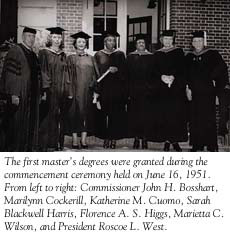Author's Note: Some information
for this article was gathered from the
book, Time the Great Teacher, which
records the history of The College from
1855-1955. Special thanks to Brenda
Cohen, archives and special collection
assistant at Roscoe L. West Library, for
her assistance. |
| Times
have certainly changed. From a student
body of 645 in 1900 to more than 6,750
students today, The College has evolved
in scope and scale far beyond the imagination
of the founding fathers. Yet despite
the overwhelming changes The College
experienced during the twentieth century,
its focus on sound scholarship and intellectual
achievement has remained strong. As
we enter a new century it seems appropriate
to reflect on the past. While in no
way comprehensive, the following information
highlights some of the things that have
made The College what it is today. |
|

|
1913
The industrial growth of the area brought
a growing demand for training in the
commercial field. To meet this need,
a commercial course appeared in the
1913 Normal School curriculum. The course
included bookkeeping, business practice,
commercial law, stenography, typing,
penmanship, economics, history, and
English. At the end of the course the
student received a certificate to teach
the subjects named, in any elementary
or high school.
1925
Authorization to grant the BS degree
brought about a marked improvement in
the professional attitude of the students.
By 1926, there were fifty students working
toward a degree. Specialization was
restricted to five fieldsEnglish, history,
science, mathematics, and rural education.
1926
The first bachelor's degrees were granted.
1932
Eighty-nine students attended the first
summer session held at the Hillwood
Lakes campus. The session was financed
by a charge of five dollars per credit.
1935
The State Board of Education adopted
a resolution that all courses of study
be made four years in length beginning
with classes entering in September 1935.
1948
The graduate program at Trenton State
Teachers College began in the 1948 summer
session with an enrollment of eleven.
The graduate program offered elementary
teachers opportunities to increase their
knowledge of content subjects and to
continue the specific professional preparation
required for elementary school teaching.
|
|
Stats*
|
|
Year
|
Average combined SAT
|
Average Rank
in HS Class (percentile)
|
|
1980
|
927
|
74
|
|
1985
|
1015
|
77
|
|
1990
|
1112
|
91
|
|
1995
|
1158
|
90
|
|
1999
|
1242
|
90
|
| |
|
*regularly
admitted students |
|
|
1951
The first master's degrees were granted
with five students receiving the degree
of Master of Science in Education.
1959
Approval of the school nursing program
was granted and an undergraduate curriculum
in speech arts and speech correction
was offered. In addition, graduate
programs in business education and
special education were offered. 1960
Granting of the first Bachelor of
Arts degrees.
1965
Authorization was given to grant baccalaureate
degrees in nursing and the liberal
arts.
1966
The enactment of the Higher Education
Act of 1966 paved the way for The
College to become a multipurpose institution
by expanding its degree programs into
a variety of fields other than education.
1970s
During this period of declining enrollments,
when many colleges were lowering admission
standards and increasing enrollments
to maintain enrollment-driven budgets,
Dr. Clayton R. Brower and his administration
made the momentous decision to set
The College on a course of increased
selectivity by raising instead of
lowering admissions standards. Since
that time interest in The College
has increased and the academic profile
of entering students has risen steadily.
|
1972
A reorganization of The College's academic
structure resulted in a School of Arts
and Sciences, a School of Education,
and separate Divisions of Business,
Nursing, and Industrial Education and
Technology. The success of the broader
curriculum was affirmed in 1972, when
seventy percent of entering freshmen
selected non-teaching majors.
1979
The TSC Chapter of Phi Kappa Phi national
honor society was established in winter
1979. The first group of ninety-two
student members was inducted during
a dinner ceremony. The chapter was the
third in New Jersey and the 208th in
the nation to be organized since Phi
Kappa Phi's founding in 1897.
1981
In a move that was viewed as "a
milestone in the development of The
College," three of the academic divisions
officially became schools within The
College. The new School of Business,
School of Industrial Education and Engineering
Technology, and School of Nursing joined
the School of Arts and Sciences and
the School of Education.
1986
The College was first profiled in Money
magazine as one of the "Ten Public
Colleges with an Ivy Twist." Since that
time, The College has received continuing
national recognition for its excellence
and value, including in U.S. News and
World Report, The Fiske Guide to Colleges,
Barron's Profiles of American Colleges,
Peterson's Competitive Colleges and
as a "Top Ten Best Buy" every year
Money magazine published its survey.
|
1991
Approval was granted for the School
of Business to award the Bachelor of
Science in Accountancy. Previously the
school awarded the Bachelor of Science
in Business Administration with a specialization
in accounting.
1993
The School of Technology's engineering
technology program was redesigned as
an engineering science program. The
new program leads to the Bachelor of
Science in engineering science degree.
1995
The School of Technology gains approval
to become the School of Engineering
to more accurately reflect the school's
engineering science program.
1996
The College developed and implemented
a general education program for all
students that includes a comprehensive
set of learning goals and outcomes.
The program has three components: Intellectual
Skills, the Interdisciplinary Core,
and Perspectives on the World. |
|
|
|
|


